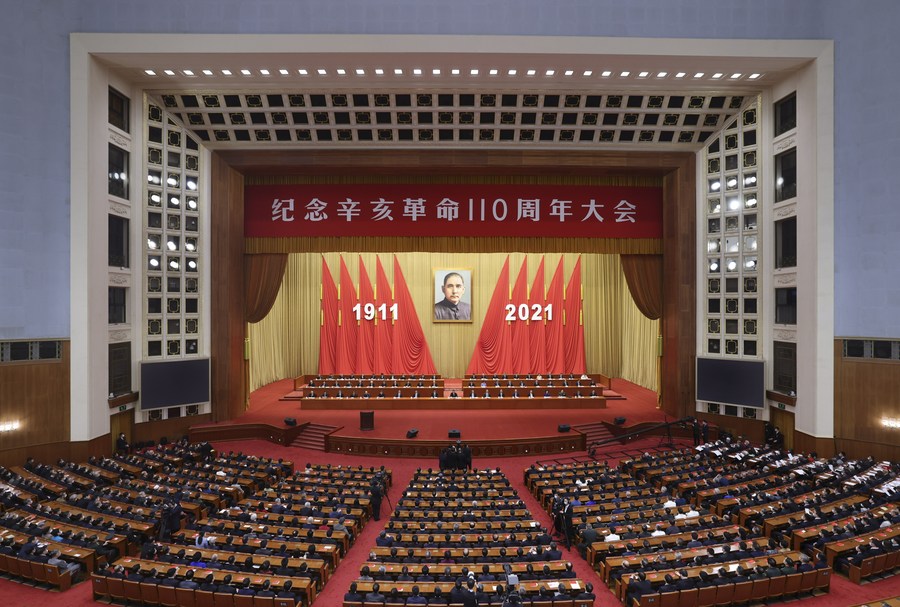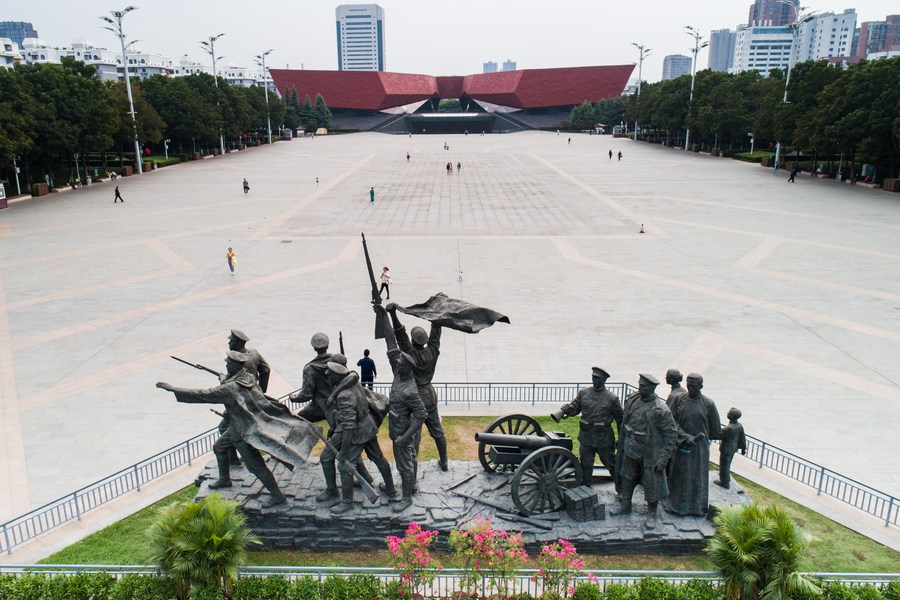Reunification and Rejuvenation

The Taiwan question arose from the weakness and chaos of China, and it will be resolved as national rejuvenation becomes a reality.
President Xi Jinping’s speech marking the 110th anniversary of the 1911 Revolution, or the Xinhai Revolution, delivered on October 9 has undoubtedly dealt a blow to “Taiwan independence” advocates both at home and abroad, as well as showcased China’s strong determination and confidence in the country’s reunification.
For about a century following the First Opium War in 1840, the Chinese nation was long trampled on and oppressed by various imperial powers. The 1911 Revolution, which was led by Dr. Sun Yat-sen and overthrew the Qing Dynasty (1644-1911) as well as put an end to the country’s over 2,000-year-old dynastic rule, ushered in an era of modern national democratic revolution in China, inspiring the exploration of the country’s great rejuvenation.
Later, under the leadership of the Communist Party of China (CPC), established in 1921 and embodying the spirit of the 1911 Revolution, the Chinese people finally toppled the three big mountains of imperialism, feudalism and bureaucrat capitalism and ended a history of imperialist oppression, thus reversing the downward spiral of the nation’s fate.

Chiang Kai-shek, leader of the Kuomintang (KMT) after Dr. Sun’s passing in 1925, betrayed Dr. Sun’s spirit by killing CPC members and plunging the country into bouts of civil war. Chiang and his administration fled to Taiwan when the Chinese people chose the CPC to rule their nation in 1949, the reason behind the estrangement between the Chinese mainland and Taiwan to this very day.
Dr. Sun had always displayed great aversion to national disintegration, as did, and do, the CPC and the Chinese people. To realize national reunification is a crucial step on the path toward the great rejuvenation of the Chinese nation. Nevertheless, “Taiwan independence” forces today prove the biggest stumbling block on the road to China’s reunification, as well as a hidden peril in the quest for China’s national rejuvenation.
Caution is warranted
Residents living on both sides of the Taiwan Straits are members of the overarching Chinese family, so when it comes to national reunification, the CPC gives priority to a peaceful reconsolidation. As President Xi pointed out, reunification by peaceful means best serves the interests of the Chinese nation as a whole, including Taiwan compatriots.
In line with the 1992 Consensus, both sides across the Straits have managed to follow the one-China principle and seek to once again unite. However, “Taiwan independence” forces are trying their utmost to obstruct this. Countries like the United States and Japan on the one hand recognize the one-China principle and the people’s government led by the CPC, while on the other hand secretively collude with Taiwan secessionists and frequently stir up trouble with the purpose of handicapping China by playing the “independent Taiwan” card. The U.S. Government, in particular, sells weapons to Taiwan and has its back through pro-Taiwan claims.
Meanwhile, the Democratic Progressive Party (DPP) in Taiwan is also fervent in disintegrating China by actively collaborating with external forces and provoking incidents, posing a threat to regional peace and stability. The DPP authorities also issued their remarks on the 110th anniversary of the 1911 Revolution, but they used this opportunity to tout “Taiwan independence” and instigate friction across the Straits, in the hopes of swaying the public’s opinion to serve their secessionist objectives.

Although both sides across the Straits are yet to be reunited, reality holds that Taiwan is an inseparable part of the Chinese territory, which is an internationally recognized principle.
“Taiwan independence” advocates have completely misjudged the situation. The Taiwan question is purely a matter of internal affairs that beckons no external interference. No one should underestimate the resolve, the will and the ability of the Chinese people to defend national sovereignty and territorial integrity. The complete reunification of China is a common goal that can, and will, be realized.
The right path
Dr. Sun once said, “Unification is the hope of all Chinese people. If China can be unified, all Chinese will enjoy a happy life; if it cannot, all will suffer.”
The 1911 Revolution helped to greatly liberate the thinking of the Chinese people and spread the notions of democracy and republicanism. It brought about the establishment of a republic on Chinese soil, the first of its kind in all of Asia. With tremendous power and profound influence, the 1911 Revolution triggered a social transformation in China and led to the search for a path to national rejuvenation. This is the revolution’s historic significance.
Constrained by the historical and social conditions of the time, and lacking the right path and leading force to determine the future of the country, the 1911 Revolution could not change the semi-colonial and semi-feudal nature of Chinese society; it could not alter the bitter fate of the Chinese people; and it could not accomplish the historic missions of national independence and the people’s liberation. Moreover, after Dr. Sun, the successive KMT regime itself cast a big shadow over the entire Chinese population.
President Xi pointed out in his speech that the Chinese communists were in fact the most steadfast supporters, loyal collaborators, and faithful successors to the revolutionary cause initiated by Dr. Sun. In retrospect, the mission of reunifying the country and realizing the great rejuvenation of the Chinese nation falls onto the CPC’s shoulders.

Overcoming various hardships, the Chinese people obtained peace under the CPC leadership. At the present stage, the Chinese people confidently stride forward, marching towards the second Centenary Goal of turning China into a great modern socialist country in all respects. The Chinese nation has achieved a tremendous transformation, from standing up and growing prosperous to becoming strong; its national rejuvenation has now become a historical inevitability.
The DPP authorities deny the 1992 Consensus and in doing so have destroyed the very foundation for any dialogue. The people and history are to make the right choice.
As President Xi pointed out, the Taiwan question arose from the weakness and chaos of China, and it will be resolved as national rejuvenation becomes a reality. The future is determined by the general tendency of shared history, but, more importantly, it is the common will of all Chinese people.
The 1992 Consensus
The 1992 Consensus was an oral agreement reached between the mainland-based Association for Relations Across the Taiwan Straits (ARATS) and the Taiwan-based Straits Exchange Foundation (SEF) as a result of their talks held from late October to early December of 1992. The two nongovernmental organizations agreed that “both sides of the Taiwan Straits would follow the one-China principle,” which subsequently became the political foundation for cross-Straits consultations.
The kernel of the 1992 Consensus is the one-China principle, which implies seeking common ground while reserving differences.
The 1992 Consensus defines cross-Straits relations as neither state-to-state nor “one China, one Taiwan,” but confirms the fact that the mainland and Taiwan belong to one China.
 Facebook
Facebook
 Twitter
Twitter
 Linkedin
Linkedin
 Google +
Google +










